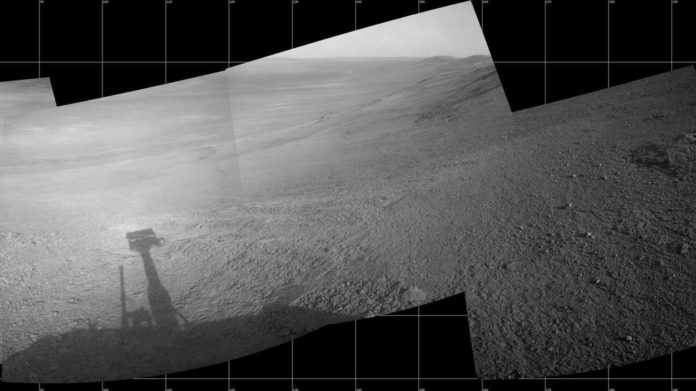A planet-enclosing dust storm on Mars, which was first recognized May 30 and ended tasks for the Opportunity rover, keeps on subsiding.
With clearing skies over Opportunity’s resting spot in Mars’ Perseverance Valley, engineers at NASA‘s Jet Propulsion Laboratory in Pasadena, California, trust the about 15-year-old, solar-powered rover will soon get enough sunlight to consequently start recuperation systems – if the wanderer can do as such. To set up, the Opportunity mission group has built up a two-step plan to give the most noteworthy likelihood of effectively communicating with the rover and bringing it back on the web.
John Callas, Opportunity project manager at JPL said, “The Sun is breaking through the haze over Perseverance Valley, and soon there will be enough sunlight present that Opportunity should be able to recharge its batteries. When the tau level [a measure of the amount of particulate matter in the Martian sky] dips below 1.5, we will begin a period of actively attempting to communicate with the rover by sending it commands via the antennas of NASA’s Deep Space Network. Assuming that we hear back from Opportunity, we will begin the process of discerning its status and bringing it back online.”
The rover last communicated with the earth on June 10 and Opportunity’s current health is unknown. Opportunity engineers are depending on the aptitude of Mars researchers examining information from the Mars Color Imager (MARCI) on board NASA’s Mars Reconnaissance Orbiter (MRO) to gauge the tau close to the meanderer’s position.

Credits: NASA/JPL-Caltech/Cornell/Arizona State Univ
MRO Project Scientist Rich Zurek at JPL said, “The dust haze produced by the Martian global dust storm of 2018 is one of the most extensive on record, but all indications are it is finally coming to a close. MARCI images of the Opportunity site have shown no active dust storms for some time within 3,000 kilometers [about 1,900 miles] of the rover site.”
Callas said, “With skies clearing, mission managers are hopeful the rover will attempt to call home, but they are also prepared for an extended period of silence. “If we do not hear back after 45 days, the team will be forced to conclude that the Sun-blocking dust and the Martian could have conspired to cause some type of fault from which the rover will more than likely not recover. At that point, our active phase of reaching out to Opportunity will be at an end. However, in the unlikely chance that there is a large amount of dust sitting on the solar arrays that are blocking the Sun’s energy, we will continue passive listening efforts for several months.”
The additional several months for passive listening are a recompense for the likelihood that a Red Planet dust devil could tag along and truly dust off Opportunity’s solar clusters. Such “cleaning events” were first found Mars meanderer groups in 2004 when, on a few events, battery power levels on board both Spirit and Opportunity expanded by a few percent amid a solitary Martian night, when the logical expectation was that they would keep on decreasing. These cleaning dust fiends have even been imaged by the two meanderers at first glance and shuttle in orbit.
The chances are small that dust accumulation would be the root cause of Opportunity’s lack of communication. Nonetheless, each day during the passive phase, JPL’s Radio Science group will scour the signal records taken by a very sensitive broadband receiver of radio frequencies emanating from Mars, looking for a sign that the rover is trying to reach out.
Even if the team hears back from Opportunity during either phase, there is no assurance the rover will be operational. The impact of this latest storm on Opportunity’s systems is unknown but could have resulted in reduced energy production, diminished battery performance, or other unforeseen damage that could make it difficult for the rover to fully return online.
While the situation in Perseverance Valley is critical, the team group is circumspectly optimistic, realizing that Opportunity has conquered huge difficulties amid its 14 or more years on Mars. The wanderer lost utilization of its front steering- its left-front in June of 2017, and right front in 2005.
Its 256-megabyte flash memory is no longer functioning. The team also knows that everything about the rover is well beyond its warranty period — both Opportunity and its twin rover, Spirit, were constructed for 90-day missions (Spirit lasted 20 times longer and Opportunity is going on 60 times). The rovers were designed to travel about 1,000 yards, and Opportunity has logged more than 28 miles. Through thick and thin, the team has seen their rover soldier on. Now, Opportunity engineers and scientists of Opportunity are planning, and hoping, that this latest dilemma is just another bump in their Martian road.
